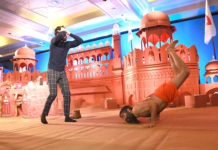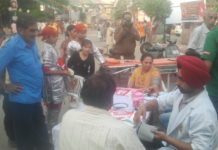Here are the most important and revolutionary arts by the Feminist artists
Womanhouse,1972 (Mixed media site installation)
Artist: Judy Chicago and Miriam Schapiro


Womanhouse was an installation that encompassed an entire house in residential Hollywood organised by Judy Chicago and Miriam Schapiro as the culmination of the Feminist Art Program (FAP) at California Institute for the Arts in 1972. The twenty-one all-female students first renovated the house, which had been previously marked for demolition, then installed site-specific art environments within the interior spaces that ranged from the sculptural figure of a woman trapped within a linen closet to a kitchen where the walls and ceiling were covered with fried eggs that morphed into breasts. Many of the artists also created performances that took place within Womanhouse to further address the relationship between women and the home. The entire collaborative piece was about reclaiming domestic space and challenging traditional female roles. It gave women a new realm to express their views within a thoroughly integrated context of art and life.
Anatomy of a Kimono, 1974 (Fabric and acrylic on canvas)
Artist: Miriam Schapiro

Artwork description & Analysis: Anatomy of a Kimono is one of many “femmages” Schapiro created, starting in the mid-1970s, and is based on the patterns of Japanese kimonos, fans, and robes. Schapiro used the term femmage to describe works that combined collage, painting, fabric, embroidery and other “high art” and “decorative art” techniques, simultaneously highlighting women’s relation to those materials and processes. The artist collected donated handkerchiefs while touring the country and cobbled them together with other fabrics to form ten large panels filled with Japanese-inspired shapes. The work adopts the monumental scale of Abstract Expressionist canvases, but by using fabric instead of paint, Schapiro elevates a utilitarian and feminine material to the realm of “high art.”
Semiotics of the Kitchen, 1975 (Black and white video with sound – Electronic Arts Intermix)
Artist: Martha Rosler
Semiotics of the Kitchen examines women’s relationship to the home through the trope of the televised cooking show. Rosler describes the video stating, “an anti-Julia Child replaces the domesticated ‘meaning’ of tools with a lexicon of rage and frustration.” Rosler parodically adopted the role of the “host,” and runs through an alphabetical index of kitchen utensils, illustrating their use and action with pantomime. The woman and her implements disrupt the familiar system of everyday meanings – the safely understood signs of food production erupt into anger and violence. In list of kitchen implements, states Rosler, “when the woman speaks, she names her own oppression.” She, like many feminist artists of the 1970s, wished to interrupt and change the preconceived notions about women’s roles within the home, and how these were represented in the mass media.
The Dinner Party, 1974-1979 (Painted porcelain plates, silverware, chalices, fabric, tiles – Brooklyn Museum)
Artist: Judy Chicago


Artwork description & Analysis: The Dinner Party is one of the most well-known pieces of Feminist art in existence and is permanently housed at the Center for Feminist Art at the Brooklyn Museum. The installation consists of a large banquet table with place settings for thirty-nine notable women from history and mythology. The settings have gold ceramic chalices and porcelain plates painted with butterfly- and vulva-inspired designs. In addition to the thirty-nine settings, there are the names of 999 other women painted on the tiles below the triangular table. The Dinner Party participates in the feminist revision of history, initiated during the 1970s, in which feminists worked to re-discover lost role models for women, re-writing the past that had previously only included male voices. In the combination of intricately wrought textiles, tile, and porcelain, Chicago reclaimed the realm of “high art” to include what had traditionally been relegated to the lower status of “women’s work.”
Image courtesy: googleimages(top), blogspot.com(bottom)
Three Weeks in May, 1977 (Performance)
Artist: Suzanne Lacy

 Three Weeks in May was a three-week-long extended artwork. Lacy wanted to bring attention to how frequently women were assaulted, sexually or otherwise, on the streets of Los Angeles. The piece consisted of performances, public drawings, and installations. In this image, Lacy is marking the site where two women were raped by proclaiming it in large red lettering on the sidewalk and then drawing an outline of a body similar to the chalk outlines of murder victims used by the police. Speaking about Three Weeks in May, Lacy stated, “It was used as both [an] organizing device to bring people from different anti-violence organizations and different political perspectives together on the same programs – and as a way to create public dialogue on rape and women’s solutions for it.” The piece engages with many facets of Feminist art through its message of social awareness, expression of women’s social and personal perspectives, and the use of performance and installation as opposed to traditional media like sculpture or painting.
Three Weeks in May was a three-week-long extended artwork. Lacy wanted to bring attention to how frequently women were assaulted, sexually or otherwise, on the streets of Los Angeles. The piece consisted of performances, public drawings, and installations. In this image, Lacy is marking the site where two women were raped by proclaiming it in large red lettering on the sidewalk and then drawing an outline of a body similar to the chalk outlines of murder victims used by the police. Speaking about Three Weeks in May, Lacy stated, “It was used as both [an] organizing device to bring people from different anti-violence organizations and different political perspectives together on the same programs – and as a way to create public dialogue on rape and women’s solutions for it.” The piece engages with many facets of Feminist art through its message of social awareness, expression of women’s social and personal perspectives, and the use of performance and installation as opposed to traditional media like sculpture or painting.
Image courtesy: feminismo y cultura (top), StudyBlue (bottom)




























